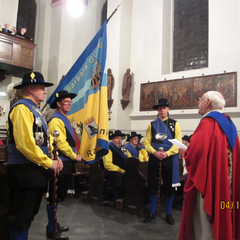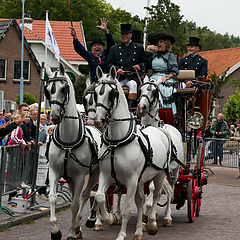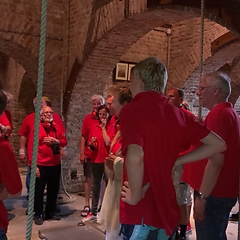The Star of the Sea Walk of Prayer (hereafter: Walk of Prayer) is a centuries-old fixed route through the centre of Maastricht, starting at the candle chapel of Our Lady Star of the Sea and returning there. While walking the Walk of Prayer, the Rosary is prayed. The Walk of Prayer can be walked individually or in groups or in the form of a procession.
The “Grand Walk of Prayer” is a procession with the statue of Our Lady Star of the Sea in front, decorated with flowers, carried on the shoulders by the Bearers' Guild and flanked by the Brotherhood with flambeaus, followed by clergy, acolytes and faithful. There is a fixed order of the procession and a dress code for those participating in the procession. During the Walk of Prayer, the Rosary is prayed (recited over megaphone) and chanting takes place. After returning to the basilica, the Litany of Mary is prayed and the song “O Purest of Creatures” is sung.
The “Kleine Bidweg” (Little Walk of Prayer) is a smaller group of believers, who walk the route without the statue of the Star of the Sea, praying the Rosary. It starts with a gathering at the candle chapel. There, the Brother Master of the Brotherhood pronounces the prayer intentions as intercessor at the statue of Our Lady Star of the Sea. After this, the participants leave the candle chapel and walk the Walk of Prayer praying the Rosary.
The route of the Walk of Prayer is marked by gable stones with statues of Mary. These statues in themselves form one of the cultural core values of the Walk of Prayer.
The Walk of Prayer of the Star of the Sea and Our Lady Star of the Sea are inseparable. Our Lady Star of the Sea is the statue of Mary Our Lady Star of the Sea placed in the Merode Chapel of the Basilica of Our Lady of the Assumption in Maastricht.



